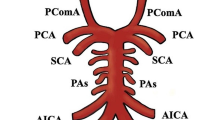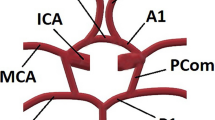Abstract
Purpose
This magnetic resonance imaging study examined the most frequent anatomical variants of the anterior communicating artery (ACoA) complex of the cerebral arterial circle, and aimed to determine whether they were associated with ACoA complex aneurysm.
Methods
The study enrolled 669 patients. Using three-dimensional time-of-flight magnetic resonance angiography, 617 patients were classified into the following groups based on the anatomical variation in the ACoA complex: no ACoA complex anomaly; ACoA complex aneurysm; and vascular anomaly distant from the cerebral arterial circle.
Results
Of the 617 classified subjects, the classical anatomical description applied to 48.73% in the no ACoA complex anomaly group and 37.5% in the ACoA complex aneurysm group. One variant (left anterior cerebral artery segment A1 hypoplasia) was significantly more frequent in the ACoA complex aneurysm group. There was no sex difference in the prevalence of any variant.
Conclusions
Anatomical variants of the ACoA complex of the cerebral arterial circle were found in almost half of the subjects. One variant seemed to be associated with a higher likelihood of an aneurysm, but causality could not be inferred.



Similar content being viewed by others
References
Ahlqvist J (2001) Stress-related intracerebral hemorrhage and the water-hammer effect. Stroke 32:275–278. https://doi.org/10.1161/01.STR.32.1.275-a
Damşa T, Appel E, Cristidis V (1976) “Blood-hammer” phenomenon in cerebral hemodynamics. Math Biosci 29:193–202. https://doi.org/10.1016/0025-5564(76)90102-4
Ding R, Xu X, Guan D, Zhu B, Zhang G, Wu X (2019) Fatal subarachnoid hemorrhage caused by rupture of variant anterior communicating artery: a case report and literature review. Forensic Sci Med Pathol 15:97–101. https://doi.org/10.1007/s12024-018-0042-3
Hannequin P, Peltier J, Destrieux C, Velut S, Havet E, Le Gars D (2013) The inter-optic course of a unique precommunicating anterior cerebral artery with aberrant origin of an ophthalmic artery: an anatomic case report. Surg Radiol Anat 35:269–271. https://doi.org/10.1007/s00276-012-1028-6
Iqbal S (2013) A comprehensive study of the anatomical variations of the circle of willis in adult human brains. J Clin Diagn Res 7:2423–2427. https://doi.org/10.7860/JCDR/2013/6580.3563
Jiménez-Sosa M, Cantu-Gonzalez J, Morales-Avalos R, Garza-Castro O, Quiroga-Garza A, Pinales-Razo R, Elizondo G, Elizondo Omaña R, López S (2017) Anatomical variants of anterior cerebral arterial circle: a study by multidetector computerized 3D tomographic angiography. Int J Morphol 35:1121–1128. https://doi.org/10.4067/S0717-95022017000300049
Kamath S (1981) Observations on the length and diameter of vessels forming the circle of Willis. J Anat 133:419–423
Kawashima M, Endo M, Kitahara T, Soma K, Fujii K (2008) Unusual location of anterior communicating artery aneurysm located on the planum sphenoidale due to long A1 segments. Neurol Med Chir (Tokyo) 48:254–256. https://doi.org/10.2176/nmc.48.254
Kayembe KN, Sasahara M, Hazama F (1984) Cerebral aneurysms and variations in the circle of Willis. Stroke 15:846–850. https://doi.org/10.1161/01.str.15.5.846
Kim MS, Sim SY (2016) Infraoptic anterior cerebral artery: case series report and literature review. Surg Radiol Anat 38:887–891. https://doi.org/10.1007/s00276-016-1651-8
Krabbe-Hartkamp MJ, van der Grond J, de Leeuw FE, de Groot JC, Algra A, Hillen B, Breteler MM, Mali WP (1998) Circle of Willis: morphologic variation on three-dimensional time-of-flight MR angiograms. Radiology 207:103–111. https://doi.org/10.1148/radiology.207.1.9530305
Krzyzewski RM, Tomaszewska IM, Lorenc N, Kochana M, Goncerz G, Klimek-Piotrowska W, Walocha K, Urbanik A (2014) Variations of the anterior communicating artery complex and occurrence of anterior communicating artery aneurysm: A2 segment consideration. Folia Med Cracov 54:13–20
Krzyżewski RM, Tomaszewski KA, Kochana M, Kopeć M, Klimek-Piotrowska W, Walocha JA (2015) Anatomical variations of the anterior communicating artery complex: gender relationship. Surg Radiol Anat 37:81–86. https://doi.org/10.1007/s00276-014-1313-7
Leipzig TJ, Morgan J, Horner TG, Payner T, Redelman K, Johnson CS (2005) Analysis of intraoperative rupture in the surgical treatment of 1694 saccular aneurysms. Neurosurgery 56:455–468. https://doi.org/10.1227/01.neu.0000154697.75300.c2 (discussion 455-468)
López-Sala P, Alberdi N, Mendigaña M, Bacaicoa M-C, Cabada T (2020) Anatomical variants of anterior communicating artery complex. A study by Computerized Tomographic Angiography. J Clin Neurosci 80:182–187. https://doi.org/10.1016/j.jocn.2020.08.019
Mahajan A, Banga V, Chatterjee A, Goel G (2020) Infraoptic course of anterior cerebral artery coexistence with double fenestration of proximal A2 segment of anterior cerebral artery with associated dysplastic anterior communicating artery aneurysm treated with stent-assisted coiling. Asian J Neurosurg 15:247–249. https://doi.org/10.4103/ajns.AJNS_193_19
Makowicz G, Poniatowska R, Lusawa M (2013) Variants of cerebral arteries—anterior circulation. Pol J Radiol 78:42–47. https://doi.org/10.12659/PJR.889403
Meyer A, Hierons R (1964) A note on Thomas Willis’ views on the corpus striatum and the internal capsule. J Neurol Sci 1:547–554. https://doi.org/10.1016/0022-510X(64)90172-8
Ravikanth R, Philip B (2019) Magnetic resonance angiography determined variations in the circle of Willis: analysis of a large series from a single center. Tzu Chi Med J 31:52–59. https://doi.org/10.4103/tcmj.tcmj_167_17
Rengachary SS, Xavier A, Manjila S, Smerdon U, Parker B, Hadwan S, Guthikonda M (2008) The legendary contributions of Thomas Willis (1621–1675): the arterial circle and beyond. J Neurosurg 109:765–775. https://doi.org/10.3171/JNS/2008/109/10/0765
Rinaldo L, McCutcheon BA, Murphy ME, Bydon M, Rabinstein AA, Lanzino G (2017) Relationship of A1 segment hypoplasia to anterior communicating artery aneurysm morphology and risk factors for aneurysm formation. J Neurosurg 127:89–95. https://doi.org/10.3171/2016.7.JNS16736
Rossitti S (2015) Letter to the Editor: the blood-hammer effect and aneurysmal basilar artery bifurcation angles. J Neurosurg 122:1512–1513. https://doi.org/10.3171/2014.12.JNS142667
Sun L, Wang J, Li M, Li M, Zhu Y (2020) The contribution of wall shear stress insult to the growth of small unruptured cerebral aneurysms in longitudinal 3D-TOF-MRA. J Neurol Sci 413:116798. https://doi.org/10.1016/j.jns.2020.116798
Tarulli E, Fox AJ (2010) Potent risk factor for aneurysm formation: termination aneurysms of the anterior communicating artery and detection of A1 vessel asymmetry by flow dilution. AJNR Am J Neuroradiol 31:1186–1191. https://doi.org/10.3174/ajnr.A2065
Turkoglu E, Arat A, Patel N, Kertmen H, Başkaya MK (2011) Anterior communicating artery aneurysm associated with an infraoptic course of anterior cerebral artery and rare variant of the persistent trigeminal artery: a case report and literature review. Clin Neurol Neurosurg 113:335–340. https://doi.org/10.1016/j.clineuro.2010.12.009
Uchino A, Nomiyama K, Takase Y, Kudo S (2006) Anterior cerebral artery variations detected by MR angiography. Neuroradiology 48:647–652. https://doi.org/10.1007/s00234-006-0110-3
Zhang X, Karuna T, Yao Z-Q, Duan C-Z, Wang X-M, Jiang S-T, Li X-F, Yin J-H, He X-Y, Guo S-Q, Chen Y-C, Liu W-C, Li R, Fan H-Y (2018) High wall shear stress beyond a certain range in the parent artery could predict the risk of anterior communicating artery aneurysm rupture at follow-up. J Neurosurg 131:868–875. https://doi.org/10.3171/2018.4.JNS173179
Zhao H, Fu J, Lu Z, Lü H (2009) Fenestration of the anterior cerebral artery detected by magnetic resonance angiography. Chin Med J (Engl) 122:1139–1142
Zurada A, Gielecki J, Tubbs RS, Loukas M, Maksymowicz W, Chlebiej M, Cohen-Gadol AA, Zawiliński J, Nowak D, Michalak M (2011) Detailed 3D-morphometry of the anterior communicating artery: potential clinical and neurosurgical implications. Surg Radiol Anat 33:531–538. https://doi.org/10.1007/s00276-011-0792-z
Acknowledgements
We wish to thank Prof. Aymeric Rouchaud and the Department of Radiology, University Hospital of Limoges, France, for allowing us to access the MRI imaging.
Author information
Authors and Affiliations
Contributions
FF, SDF and AR developed the protocol/project. AK, LJ and MB collected the data. FF and AT participated in data analysis. All authors participated in writing, editing, and approval of the final manuscript.
Corresponding author
Ethics declarations
Conflicts of interest
The authors declare no conflicts of interest regarding the publication of this article.
Additional information
Publisher's Note
Springer Nature remains neutral with regard to jurisdictional claims in published maps and institutional affiliations.
Rights and permissions
About this article
Cite this article
Fredon, F., Baudouin, M., Hardy, J. et al. An MRI study of typical anatomical variants of the anterior communicating artery complex. Surg Radiol Anat 43, 1983–1988 (2021). https://doi.org/10.1007/s00276-021-02782-x
Received:
Accepted:
Published:
Issue Date:
DOI: https://doi.org/10.1007/s00276-021-02782-x




